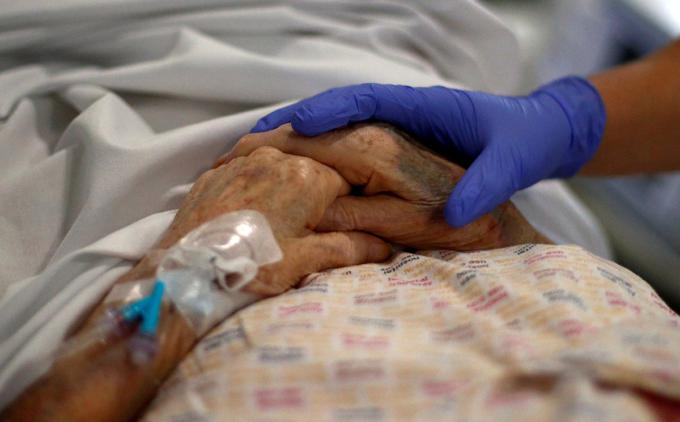
Culture
When it comes to what a "death with dignity" should look like, Mother Teresa best described it this way: "Death with dignity is to die with grace, in the knowledge that (you) are loved."

Pacholczyk
Nurses and doctors can encounter distressing images as death unfolds for their patients. Those approaching death may make odd bodily movements, give off stenches, or emit strange groans. Perhaps they are facing metastasizing cancer that leads to a courageous fight, with recurrent episodes of pain, suffering, and sadness, followed by humble submission, and eventually giving way to a lifeless corpse, mouth agape, with flies buzzing round.
Where, one can ask, is the dignity in this manner of dying?
Indeed, the physical aspects of dying and death can be very challenging, as we face the prospect of losing control of our bowels and bladder, our mind and autonomy.
Margaux Killackey sums it up this way in an essay: "All flesh will harden and turn to dust. If we judge from appearances, this is an ugly picture."
But she goes on to offer a key insight, namely, that by "looking beyond the physical aesthetics, we can find not only a life well-lived, but a death well-died."
So what does a "death well-died" look like?
One might anticipate it would arise organically out of a "life well-lived," and that both of these would involve our continued and strengthened connectedness to others, including family, friends, and God. A good death will typically be a communal event.
Mother Teresa once lamented how "we have forgotten that we belong to each other." To die surrounded by the care and support of others is to transcend our decaying bodily existence as we are sustained in a kind of wholeness through the experience of being loved. When it comes to what a "death with dignity" should look like, Mother Teresa best described it this way: "Death with dignity is to die with grace, in the knowledge that (you) are loved."
Today, as efforts continue apace to legalize physician-assisted suicide and euthanasia, flawed notions of "death with dignity" continue to enter and subvert our discussions.
One group in Britain pushing for assisted suicide and euthanasia calls itself the "Campaign for Dignity in Dying." But suicide is never dignified, no matter how much we repackage it by passing laws that grant doctors and nurses immunity from prosecution as they dole out death in place of healing.
These legislative maneuvers provide professional and legal cover for patient abandonment. Physician-assisted suicide and euthanasia are quicker, easier, and cheaper than remaining vigilant at the bedside, holding a sick person's hand, and accompanying him or her through the twists and turns of their final journey home.
Canadian euthanasia data from Quebec for 2022-2023 indicate that 70 percent of those choosing euthanasia listed "loss of dignity" as one of the motivations. We are being cajoled as a society into believing the contradiction that "death with dignity" means killing ourselves, or letting someone else kill us.
If some insist that they want access to physician-assisted suicide or euthanasia, this should remind us how much they need our care, support, and love. It should also serve to remind us of how fearful they may be at the prospect of their illness and sufferings and of the loneliness that may accompany it. This should prompt us to redouble our efforts at providing not only tailored treatments and appropriate pain management, but also compassion, companionship, and faithful accompaniment.
When Mother Teresa began her ministry in Calcutta, she would take a wheelbarrow and walk around the city to pick up individuals who were destitute and dying alone in the gutter. She would bring them back to her Home for the Dying. There, she and her sisters would care for them, pray with them, and remain in their presence until they passed on. Mother Teresa would offer them the chance to receive a gift -- what she termed a "special ticket of St. Peter" -- the Sacrament of Baptism.
No one, she said, ever declined the gift. Although their human frame was wasting away as death approached, and even though flies may have buzzed nearby, these dying individuals were able to surrender their life surrounded by love, warmth, and care, both human and divine, and experience, most assuredly, a blessed and dignified death -- a "death well-died."
A 2024 Vatican document entitled "Infinite Dignity" reminds us of the important point, often overlooked in these discussions, that suffering "does not cause the sick to lose their dignity, which is intrinsically and inalienably their own. Instead, suffering can become an opportunity to strengthen the bonds of mutual belonging."
The acceptance of the twin evils of physician-assisted suicide and euthanasia, far from promoting or supporting our core human dignity, constitutes a broadside attack against it. Both threaten those who are sick and vulnerable with systematic abandonment, not only by denying the basic protections to which they are entitled as members of the human family, but also by taking away the dignified care and loving human accompaniment due them in the final stages of their journey.
- Father Tadeusz Pacholczyk, Ph.D., earned his doctorate in neuroscience from Yale and did postdoctoral work at Harvard. He is a priest of the Diocese of Fall River and serves as senior ethicist at the National Catholic Bioethics Center in Philadelphia. See www.ncbcenter.org and www.fathertad.com.
Recent articles in the Culture & Events section
-
The honor of caring for our priestsKate Marshall
-
Scripture Reflection for April 13, 2025, Palm Sunday of the Lord's PassionDeacon Greg Kandra
-
'Put no trust in princes'Greg Erlandson
-
The power of hopeMichael Reardon
-
Scripture Reflection for March 30, 2025, Fourth Sunday of LentDeacon Greg Kandra























